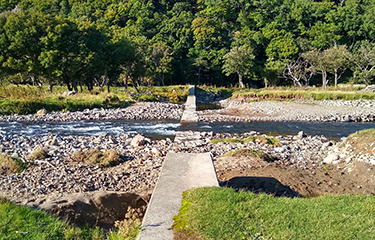Japan is enthusiastic about the UNESCO World Heritage List, seeing it as a major tourist draw. This enthusiasm is the major impetus toward an effort to restore the viability of several prime salmon rivers in the country's north.
Approving sites for the UNESCO World Heritage List often comes with requirements, such as restoring or protecting historic or natural features – this was the case when Japan applied to have Shiretoko National Park in Northeast Hokkaido listed.
The site includes land from the central part of the Shiretoko Peninsula to its tip, and the surrounding marine area. It is important for threatened seabirds and migratory birds, marine mammals including Steller sea lions and cetaceans, and a number of salmonid species. The Shiretoko site encompasses habitats in many small watersheds supporting several species of Pacific salmonids, including white spotted char, masu salmon, chum salmon, and pink salmon. The Rusha River is the largest and most central river on the site.
The International Union for Conservation of Nature (IUCN) serves as an advisory body for UNESCO. The IUCN Salmonid Specialist Group (SSG) was asked to review the World Heritage nomination proposal Japan submitted in 2005 for Shiretoko National Park. Pete Rand of the Portland, Oregon-based Wild Salmon Center (WSC) served as chairman of the group. He has since moved to the Prince William Sound Science Center in Cordova, Alaska, but continues his work for the IUCN.
As a result of the group’s recommendations, one of the requirements when the site was approved was to mitigate the impact of river constructions, including check dams and erosion control dams, on salmon migration for spawning. Rand has taken several trips to Hokkaido as part of a monitoring group to inspect progress on the restoration effort.
Japanese officials implemented several restoration projects since the proposal. A 2009 paper, “A challenge to dam improvement for the protection of both salmon and human livelihood in Shiretoko, Japan’s third Natural Heritage Site” (Nakamura et al.), reported that of 44 streams within the Shiretoko World Natural Heritage site, 14 had one or more in-stream structures, mainly soil conservation dams. Out of a total of 123 structures, the River Construction Working Group concluded that it would be reasonable to modify 31 structures in five streams to ease the movement of fish.
Three years after the modifications, the upstream runs and number of spawning beds of pink and chum salmon were monitored on the Sashirui, Chienbetsu, Iwaubetsu, and Rusha rivers. In all cases, the number of salmon spawning beds upstream from the constructions had increased. However, though a salmon hatchery on the Rusha River had been decommissioned, three dams that were constructed to protect the hatchery remained and were still impeding the migration of salmon to their spawning grounds and negatively impacting stream habitat.
“In my last visit in 2013, they made very minor modifications,” Rand said. “They put these little V-notches on the top of the dam to allow more water to pass and more fish to pass upstream. But it wasn’t sufficient to really restore the river. The dam above the river is important, but they also extend below grade, affecting the groundwater flow, which affects the egg incubation. To fully restore the river, we’re recommending the complete removal of these dams.”
Rand explained that salmon eggs incubating in the gravel streambed require oxygen that is supplied by a constant flow of water. Even though there may be water around the eggs, if the flow is impeded, the eggs will be deprived of oxygen. Additionally, when migrating salmon stage in front of a dam of even a low height, they are more vulnerable to predation than they would be in a naturally flowing river.
The IUCN Conservation Outlook Assessment in 2014 urged Japan to further modify the three dams, including consideration of the option to fully remove them, and to also consider the option of removing the concrete below surface level, and to fully decommission a road and bridge leading to the former hatchery.
“I just went on an inspection mission to meet with folks and get a handle on what kind of progress they’ve made. Recently they’ve taken dramatic steps. They’re entirely removing some dams and further modifying others. The hatchery has been removed and the bridge is no longer needed. That’s why we’re making good progress on those dams. They’re no longer needed for [flood] risk reduction,” Rand said.
Together with the IUCN World Heritage Advisory Committee, Rand will create a report and submit it to IUCN later this year.
“I saw the most dramatic changes to date on this last visit. So they are really making excellent progress. The one thing I encourage is more monitoring because it’s important to see if they’re meeting the goals of increasing salmon passage by looking at numbers of salmon in different parts of the stream. So I think they’re going to spend a bit more time on the monitoring part of it as well. I was quite pleased with what I saw,” he said.
Photo courtesy of Dr. Pete Rand







